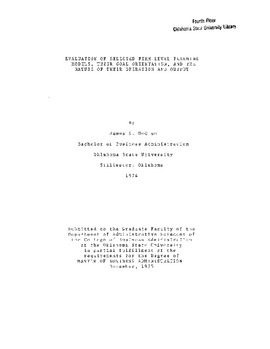| dc.contributor.advisor | Jackson, James F. | |
| dc.contributor.author | DeClue, James S. | |
| dc.date.accessioned | 2018-07-17T16:59:52Z | |
| dc.date.available | 2018-07-17T16:59:52Z | |
| dc.date.issued | 1975-12 | |
| dc.identifier.uri | https://hdl.handle.net/11244/301285 | |
| dc.description.abstract | Purpose of Report: The primary objective of this report is to exemplify how operations research techniques are applied in the design of selected firm computer-based planning models. Attention is focussed on how both simulation and optimization techniques are utilized in the firms planning process and how these techniques have been incorporated into the design of selected firm computer-based planning models. In addition to the primary objective, this report proposes to show why the application and utilization of simulation and optimization techniques when combined to form an integrated planning system, offer the planner advantages not possible otherwise. The selected models presented in this report include the Hamilton-Moses (H-M) model, Warren and Shelton (W-S) model, Sun Oil model, and the Krouse model. The selected models are all computer based corporate planning models. In addition, these models represent several classes of models developed over the years and are representative of three different operations research modeling techniques. | |
| dc.description.abstract | Finding and Conclusions: The combined approach, as depicted by the H-M model, incorporates both simulation and optimization models into an integrated planning system. The W-S model and Sun Oil model are simulation models and both represent that approach. The Krouse model represents the optimization approach. The approach chosen for development and use by the firm depends on system hardware and software, personnel capabilities, industry and firm characteristics, and no doubt many other factors. An important consideration is that the firm carefully determines if the cost of generating planning information exceeds the value of improved planning decisions. It is suggested that in the future the trend will lean toward a combination approach to firm planning. The evolution of computer technology and the obvious advantages of such an approach make such a trend inevitable. | |
| dc.format | application/pdf | |
| dc.language | en_US | |
| dc.rights | Copyright is held by the author who has granted the Oklahoma State University Library the non-exclusive right to share this material in its institutional repository. Contact Digital Library Services at lib-dls@okstate.edu or 405-744-9161 for the permission policy on the use, reproduction or distribution of this material. | |
| dc.title | Evaluation of selected firm-level planning models, their goal orientation, and the nature of their operation and output | |
| osu.filename | Thesis-1975R-D296e.pdf | |
| osu.accesstype | Open Access | |
| dc.type.genre | Master's Report | |
| dc.type.material | Text | |
| thesis.degree.discipline | Business Administration | |
| thesis.degree.grantor | Oklahoma State University | |
